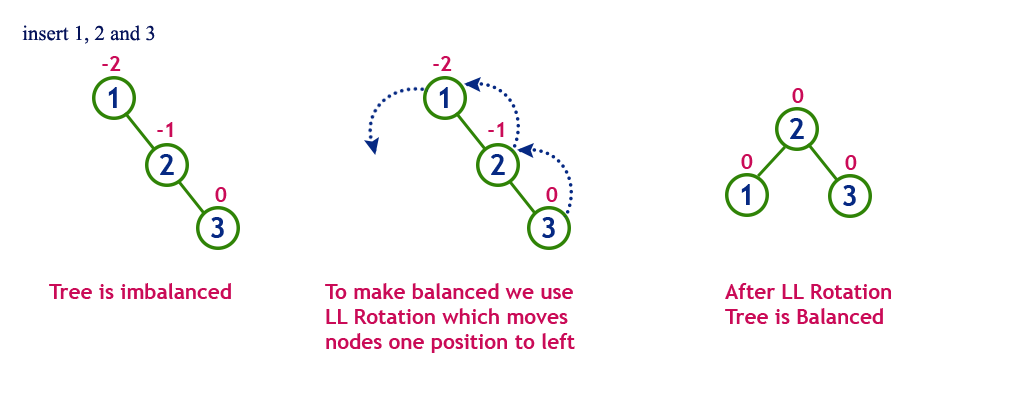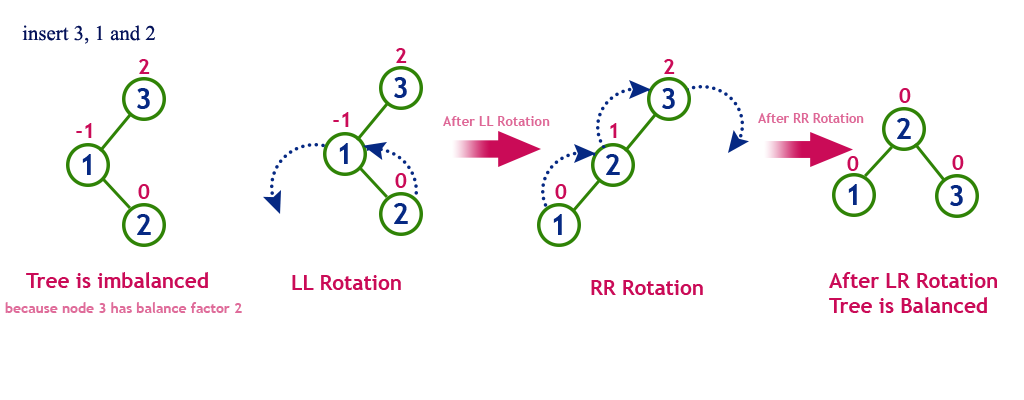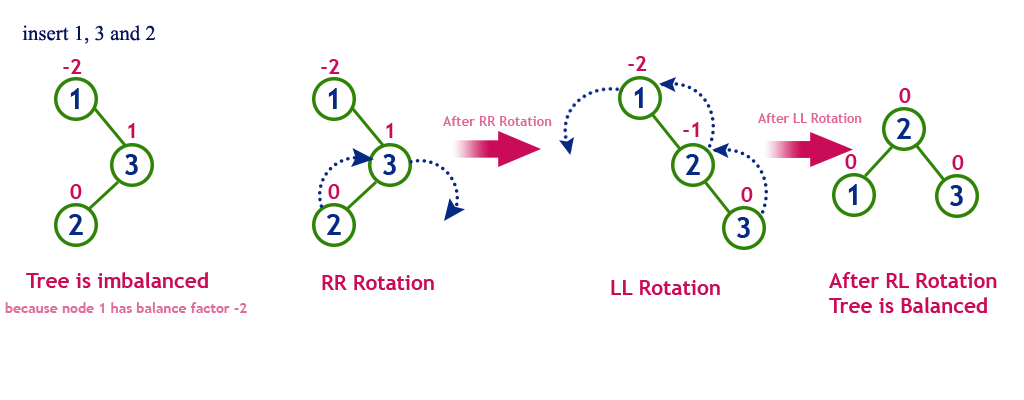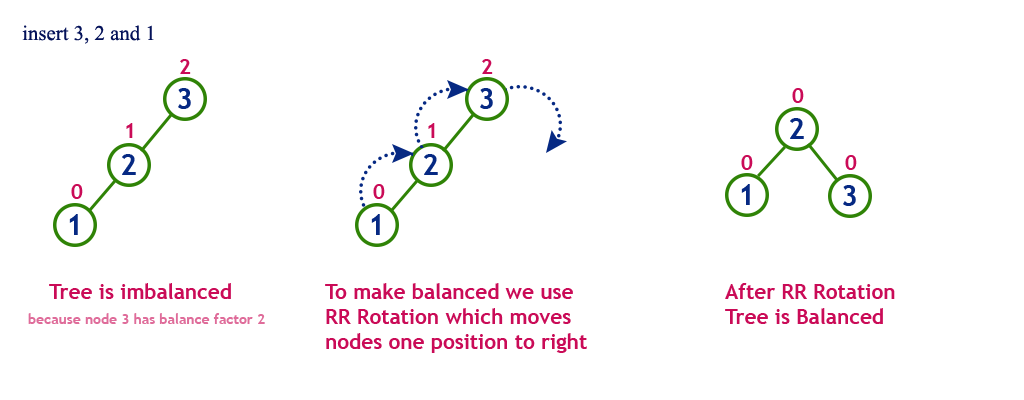AVL 트리: 두 판 사이의 차이
IT 위키
(→동작 예시) |
AlanTuring (토론 | 기여) 편집 요약 없음 |
||
| 9번째 줄: | 9번째 줄: | ||
* B 트리 등과 함께 균형잡힌 트리(height-balanced tree)라고도 불림 | * B 트리 등과 함께 균형잡힌 트리(height-balanced tree)라고도 불림 | ||
== 균형 인수 == | |||
균형 인수(Balance Factor, BF)는 노드의 왼쪽 서브트리와 오른쪽 서브트리의 높이 차이를 의미한다. | |||
{| class="wikitable" | |||
|+균형 인수의 의미 | |||
!균형 인수 (BF)!!트리 상태 | |||
|- | |||
| -1, 0, 1||균형 상태 (Balanced) | |||
|- | |||
|< -1 또는 > 1||불균형 상태 (Unbalanced, 회전 필요) | |||
|} | |||
== 회전 동작 == | == 회전 동작 == | ||
=== 개요 === | === 개요 === | ||
| 26번째 줄: | 36번째 줄: | ||
* LL 회전 | * LL 회전 | ||
[[파일:AVL RR Rotation.png|600px]] | [[파일:AVL RR Rotation.png|600px]] | ||
== 구현 코드 == | |||
=== Python === | |||
<syntaxhighlight lang="python"> | |||
class Node: | |||
def __init__(self, key): | |||
self.key = key | |||
self.left = None | |||
self.right = None | |||
self.height = 1 | |||
class AVLTree: | |||
def get_height(self, node): | |||
return node.height if node else 0 | |||
def get_balance(self, node): | |||
return self.get_height(node.left) - self.get_height(node.right) if node else 0 | |||
def right_rotate(self, z): | |||
y = z.left | |||
T3 = y.right | |||
y.right = z | |||
z.left = T3 | |||
z.height = max(self.get_height(z.left), self.get_height(z.right)) + 1 | |||
y.height = max(self.get_height(y.left), self.get_height(y.right)) + 1 | |||
return y | |||
def left_rotate(self, z): | |||
y = z.right | |||
T2 = y.left | |||
y.left = z | |||
z.right = T2 | |||
z.height = max(self.get_height(z.left), self.get_height(z.right)) + 1 | |||
y.height = max(self.get_height(y.left), self.get_height(y.right)) + 1 | |||
return y | |||
def insert(self, root, key): | |||
if not root: | |||
return Node(key) | |||
if key < root.key: | |||
root.left = self.insert(root.left, key) | |||
else: | |||
root.right = self.insert(root.right, key) | |||
root.height = max(self.get_height(root.left), self.get_height(root.right)) + 1 | |||
balance = self.get_balance(root) | |||
# LL 회전 | |||
if balance > 1 and key < root.left.key: | |||
return self.right_rotate(root) | |||
# RR 회전 | |||
if balance < -1 and key > root.right.key: | |||
return self.left_rotate(root) | |||
# LR 회전 | |||
if balance > 1 and key > root.left.key: | |||
root.left = self.left_rotate(root.left) | |||
return self.right_rotate(root) | |||
# RL 회전 | |||
if balance < -1 and key < root.right.key: | |||
root.right = self.right_rotate(root.right) | |||
return self.left_rotate(root) | |||
return root | |||
# AVL 트리 테스트 | |||
avl = AVLTree() | |||
root = None | |||
for key in [10, 20, 30, 40, 50, 25]: | |||
root = avl.insert(root, key) | |||
</syntaxhighlight> | |||
== 같이 보기 == | == 같이 보기 == | ||
{{틀:데이터베이스 인덱스 트리}} | {{틀:데이터베이스 인덱스 트리}} | ||
2025년 2월 13일 (목) 08:25 판
- Adelson-Velskii and Landis Tree
- 트리내 각각의 노드마다 1 이하의 균형치(Balance Factor, +1,0,1)를 가지기 위해, 삽입과 삭제를 할때마다 균형치를 검사하여 RR, LL, LR, RL 회전연산을 시행하는 이진탐색트리
- 발표자인 1962년 G.M. Adelson-Velskii와 E.M. Landis 가 그들의 이름을 따서 명명
특징
- 한 노드를 중심으로 좌우 종속 트리의 높이 차가 1 이하인 균형 잡힌 트리
- 이진 트리의 삽입·삭제 과정에서 한 방향으로 치우치거나, 높이 차이로 인해서 수행 시간이 증가되는 것을 막기 위해 균형 유지
- B 트리 등과 함께 균형잡힌 트리(height-balanced tree)라고도 불림
균형 인수
균형 인수(Balance Factor, BF)는 노드의 왼쪽 서브트리와 오른쪽 서브트리의 높이 차이를 의미한다.
| 균형 인수 (BF) | 트리 상태 |
|---|---|
| -1, 0, 1 | 균형 상태 (Balanced) |
| < -1 또는 > 1 | 불균형 상태 (Unbalanced, 회전 필요) |
회전 동작
개요
- LL 회전: A 로부터 N 까지의 경로상의 노드들을 오른쪽으로 회전
- LR 회전: A 로부터 N 까지의 경로상의 노드들을 왼쪽-오른쪽으로 회전
- RL 회전: A 로부터 N 까지의 경로상의 노드들을 오른쪽-왼쪽으로 회전
- RR 회전: A 로부터 N 까지의 경로상의 노드들을 왼쪽으로 회전
동작 예시
- RR 회전
- LR 회전
- RL 회전
- LL 회전
구현 코드
Python
class Node:
def __init__(self, key):
self.key = key
self.left = None
self.right = None
self.height = 1
class AVLTree:
def get_height(self, node):
return node.height if node else 0
def get_balance(self, node):
return self.get_height(node.left) - self.get_height(node.right) if node else 0
def right_rotate(self, z):
y = z.left
T3 = y.right
y.right = z
z.left = T3
z.height = max(self.get_height(z.left), self.get_height(z.right)) + 1
y.height = max(self.get_height(y.left), self.get_height(y.right)) + 1
return y
def left_rotate(self, z):
y = z.right
T2 = y.left
y.left = z
z.right = T2
z.height = max(self.get_height(z.left), self.get_height(z.right)) + 1
y.height = max(self.get_height(y.left), self.get_height(y.right)) + 1
return y
def insert(self, root, key):
if not root:
return Node(key)
if key < root.key:
root.left = self.insert(root.left, key)
else:
root.right = self.insert(root.right, key)
root.height = max(self.get_height(root.left), self.get_height(root.right)) + 1
balance = self.get_balance(root)
# LL 회전
if balance > 1 and key < root.left.key:
return self.right_rotate(root)
# RR 회전
if balance < -1 and key > root.right.key:
return self.left_rotate(root)
# LR 회전
if balance > 1 and key > root.left.key:
root.left = self.left_rotate(root.left)
return self.right_rotate(root)
# RL 회전
if balance < -1 and key < root.right.key:
root.right = self.right_rotate(root.right)
return self.left_rotate(root)
return root
# AVL 트리 테스트
avl = AVLTree()
root = None
for key in [10, 20, 30, 40, 50, 25]:
root = avl.insert(root, key)




